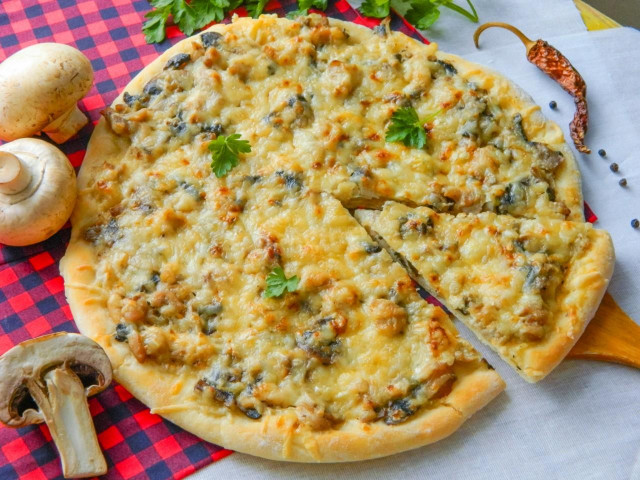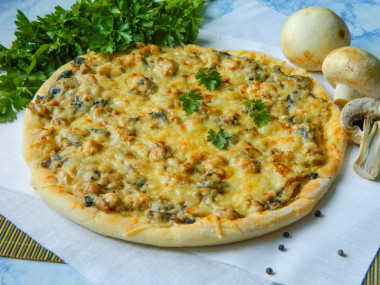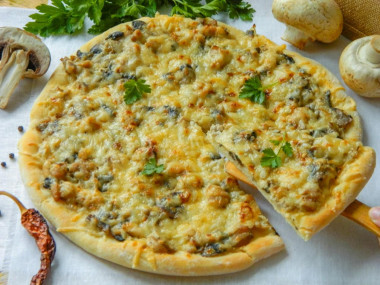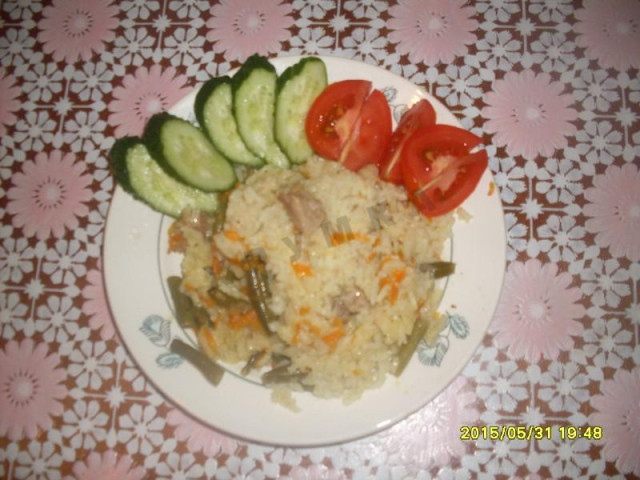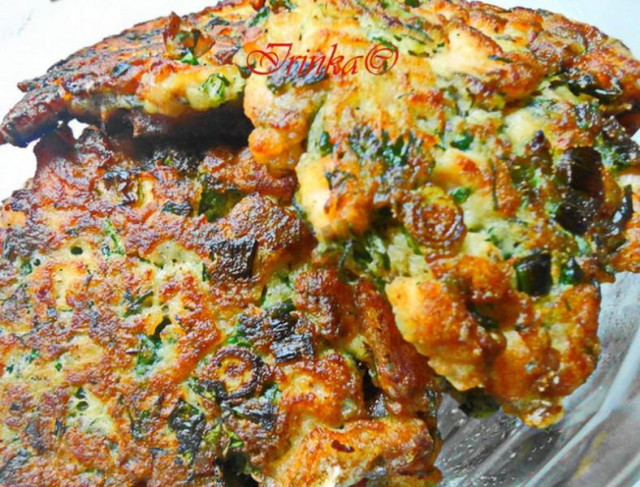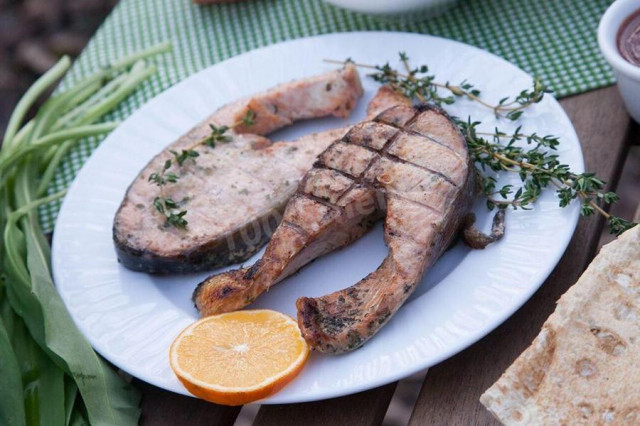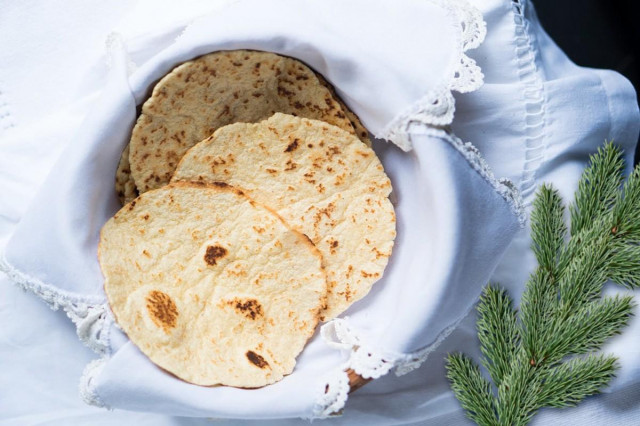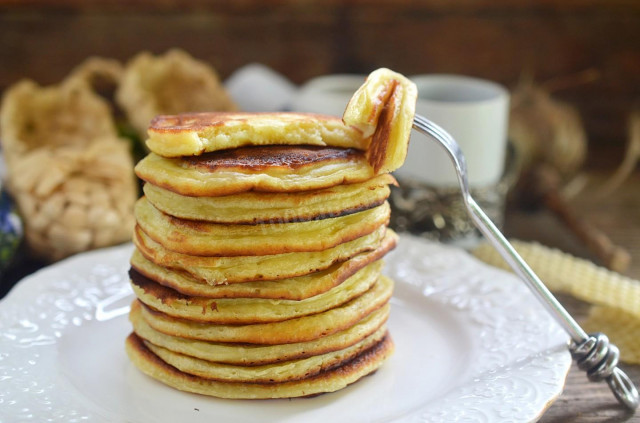Composition / ingredients
Step-by-step cooking
Step 1:
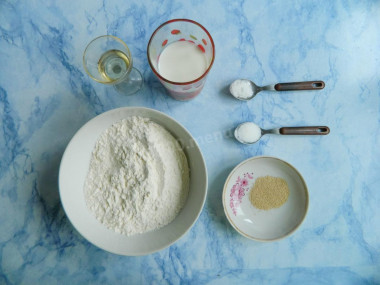
Start cooking pizza with dough. Prepare all the necessary ingredients. Olive oil is used in the classic pizza dough recipe. But it can be replaced with any other refined vegetable oil. Use flour of the highest grade. Milk is suitable for any fat content.
Step 2:
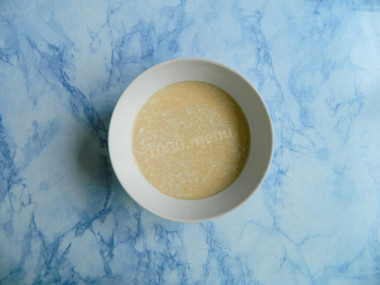
Before using yeast, read the instructions for them. There are different types of yeast - some need to be activated by first dissolving in warm water or milk, and some can be immediately added to flour. Those that need to be activated will suit us. In warm milk (37-40°C) add sugar and yeast. Stir and leave for 10 minutes. If a fluffy cap appears on the surface, then the yeast has become active and you can continue cooking.
Step 3:

To knead the dough, take a deep bowl in which it will be convenient to mix dry and liquid ingredients, or a wide horizontal work surface. I'll knead on the board. Sift the flour to sift out small debris and the dough is saturated with oxygen. Pour half of the flour into a bowl (or onto the surface). Add salt and mix it with flour so that the dough is evenly salted. Make a recess in the middle of the flour.
Step 4:

Pour half of the olive oil into the flour and the yeast diluted in milk in small portions. Be sure to add the liquid component to the dry one, and not vice versa. So the dough will turn out the most successful. Since the properties of flour of the same grade, but different manufacturers may differ, in order to get the desired consistency, add flour in small portions. Leave a little flour (about 1 tablespoon) on the bottom.
Step 5:
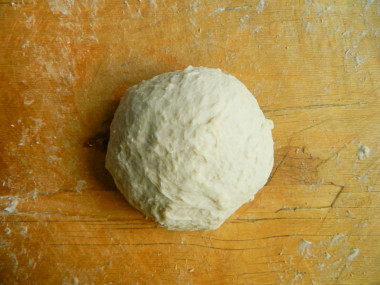
The dough should be soft and tender, but not stick to your hands. Lubricate the bottom and sides of the bowl with olive oil so that the dough does not stick to the dishes. Also knead the finished dough with your hands with butter. Cover the bowl with a napkin or towel so that it does not dry and rises well. Leave in a warm place for about 1-1.5 hours.
Step 6:
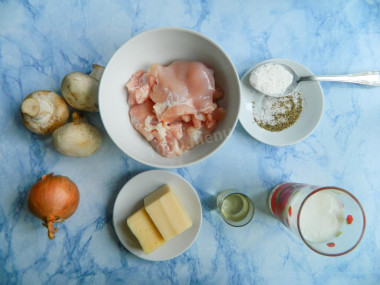
While the dough is rising, prepare the filling. The classic version of this pizza uses chicken breast fillet. However, I like chicken meat from the thigh more, pizza becomes even tastier with it. Champignons are suitable fresh or frozen. Take milk with a fat content of at least 2%, vegetable oil - any.
Step 7:
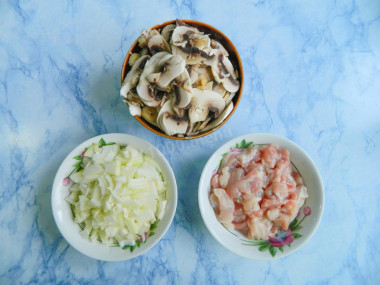
Wash the chicken, dry it with paper towels so that there are fewer splashes when frying. Cut it into thin strips. Peel the onion, rinse and cut into thin half rings. So they will cook quickly and remain whole pieces. If you want the onion not to be visible in the filling, chop it into small cubes. Peel the champignons, rinse and cut into thin plates. This way the taste of mushrooms will be preserved better and they will cook faster.
Step 8:
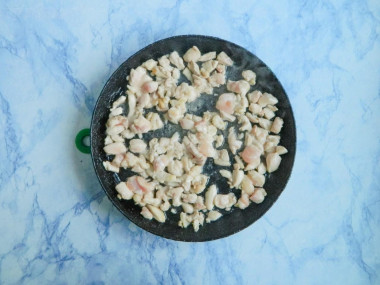
To fry the filling, take a frying pan with a diameter of at least 22 cm in order to fit the whole filling. Heat it over medium heat. Pour out the oil and fry the chicken meat over medium heat, stirring occasionally, until it turns white.
Step 9:
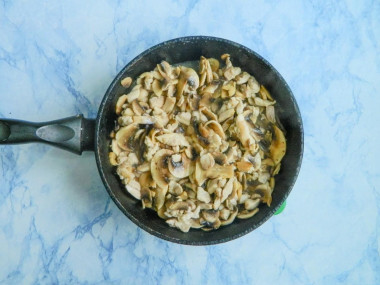
Add the mushrooms and fry for another 5-10 minutes. If you use frozen champignons, be prepared for the fact that the frying time may increase, as they emit a lot of moisture. Orient yourself like this - if the products do not "float" in the water, then add onions next.
Step 10:
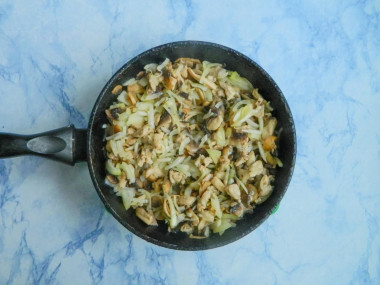
Season with salt and pepper. Fry everything together until the moisture completely evaporates.
Step 11:
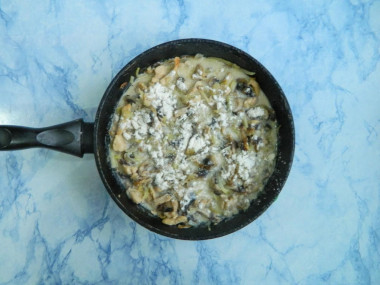
Add milk to the pan. Bring to a boil over high heat, stirring constantly. Reduce the heat, sift flour on top of the filling. Stirring constantly, put out the filling for another 2-3 minutes so that it thickens.
Step 12:
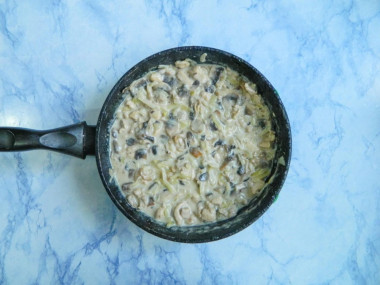
The filling is ready, leave it to cool. Turn on the oven to preheat at 200 degrees.
Step 13:
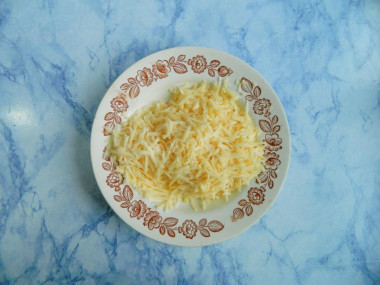
Grate the cheese on a coarse grater.
Step 14:
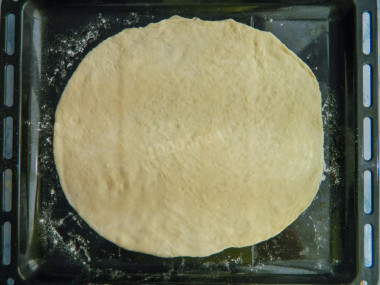
During this time, the dough should increase several times. Roll it out with a rolling pin or hands into a round layer with a diameter of about 30 cm. Leave the edges thicker to form a rim.
Step 15:
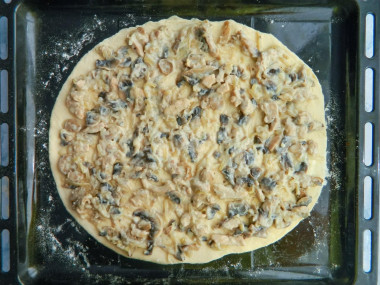
Spread the filling evenly over the dough.
Step 16:

Sprinkle grated cheese on top. Bake for 15-20 minutes on the middle shelf of a preheated oven to 200 degrees with the "top-bottom" mode. The cooking time depends on the characteristics of your oven, so check the readiness. In the finished pizza, the dough will rise and slightly brown. When pressed gently with the palm of your hand, the dough should not "walk".
The pizza dough turns out to be airy, the filling is tender with creamy notes, and a cheese crust on top.
It is baked very quickly. This is pleasing, because the preparation of the filling takes longer than for other types of pizza.
--------------------
Be prepared for the fact that flour may require a little more or, conversely, less than indicated in the recipe. You need to focus on how the dough should turn out (dense, soft, liquid, etc.). There is a lot of useful information about why flour, even of the same variety, can have completely different properties,
read this article
.
Keep in mind that everyone's ovens are different. The temperature and cooking time may differ from those specified in the recipe. To make any baked dish turn out successfully, use useful information in the article about ovens here .
Caloric content of the products possible in the composition of the dish
- Whole cow's milk - 68 kcal/100g
- Milk 3.5% fat content - 64 kcal/100g
- Milk 3.2% fat content - 60 kcal/100g
- Milk 1.5% fat content - 47 kcal/100g
- Concentrated milk 7.5% fat content - 140 kcal/100g
- Milk 2.5% fat content - 54 kcal/100g
- Champignons - 24 kcal/100g
- Dutch cheese - 352 kcal/100g
- Swiss cheese - 335 kcal/100g
- Russian cheese - 366 kcal/100g
- Kostroma cheese - 345 kcal/100g
- Yaroslavsky cheese - 361 kcal/100g
- Altai cheese 50% fat content - 356 kcal/100g
- Soviet cheese - 400 kcal/100g
- Cheese "steppe" - 362 kcal/100g
- Uglich cheese - 347 kcal/100g
- Poshekhonsky cheese - 350 kcal/100g
- Lambert cheese - 377 kcal/100g
- Appnzeller cheese with 50% fat content - 400 kcal/100g
- Chester cheese with 50% fat content - 363 kcal/100g
- Edamer cheese with 40% fat content - 340 kcal/100g
- Cheese with mushrooms of 50% fat content - 395 kcal/100g
- Emmental cheese with 45% fat content - 420 kcal/100g
- Gouda cheese with 45% fat content - 356 kcal/100g
- Aiadeus cheese - 364 kcal/100g
- Dom blanc cheese (semi-hard) - 360 kcal/100g
- Lo spalmino cheese - 61 kcal/100g
- Cheese "etorki" (sheep, hard) - 401 kcal/100g
- White cheese - 100 kcal/100g
- Fat yellow cheese - 260 kcal/100g
- Altai cheese - 355 kcal/100g
- Kaunas cheese - 355 kcal/100g
- Latvian cheese - 316 kcal/100g
- Limburger cheese - 327 kcal/100g
- Lithuanian cheese - 250 kcal/100g
- Lake cheese - 350 kcal/100g
- Gruyere cheese - 396 kcal/100g
- Ground black pepper - 255 kcal/100g
- Granulated sugar - 398 kcal/100g
- Sugar - 398 kcal/100g
- Vegetable oil - 873 kcal/100g
- Salt - 0 kcal/100g
- Onion - 41 kcal/100g
- Wheat flour - 325 kcal/100g
- Olive oil - 913 kcal/100g
- Parmesan cheese 45% fat content - 389 kcal/100g
- Chicken breast (fillet) - 113 kcal/100g
- Dry yeast - 410 kcal/100g

